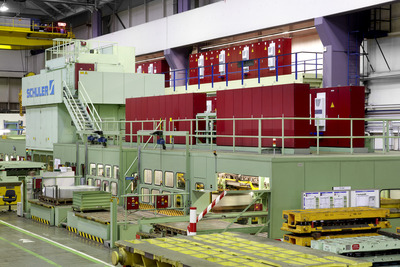Automaker achieves 70% energy savings with latest cooling technology
Tuesday, 16 April, 2013
The potential for innovations in enclosure cooling units is far from exhausted. There is still significant scope for boosting efficiency, as verified by a pilot application at Daimler AG in Sindelfingen.
The automotive manufacturer, one of the world’s leading suppliers of premium cars, put the new energy-saving cooling units from Rittal’s ‘Blue e’ generation through an exhaustive battery of live tests. The outcome revealed that converting more than 250 cooling units to the new energy-saving technology would enable savings of 490 tonnes of CO2 each year - which translates into six-figure savings in operating costs.
For Daimler AG, environmental protection is an integral part of the corporate strategy. The automotive manufacturer’s claim to ‘Green Technology Leadership’ begins with the vehicle technology - hybrid, fuel cell and electric vehicles - and extends into its production plant. For example, at the Sindelfingen press plant that consumes around 40,000 MWh a year, there is significant potential for improving energy efficiency. At this plant, pressed parts are manufactured for virtually the entire vehicle portfolio, which includes Smart, Mercedes-Benz and Maybach. Significant savings can be made here with the efficient cooling of enclosures and switchgear systems. Until now, Daimler has relied predominantly on standard cooling units from Rittal, with a few exceptions. However, a direct comparison with the new Rittal ‘Blue e’ refrigeration units revealed potential energy savings of up to 70%. While the former demanded 1169.6 kWh of primary energy, the new units required 345.8 kWh for operation under identical conditions.

On the basis of these test results, Daimler AG decided to replace the old cooling units with new ones as soon as possible, and to refit all switchgear in the press plant by 2012. The automotive manufacturers placed an order for more than 250 new units, even before they were officially available. Once all the cooling units have been replaced, the electricity saving at the Sindelfingen press plant will total some 754,000 kWh a year, corresponding to around 490 tonnes of CO2 - not to mention operating costs of around €116,000 a year.
In the past, maintenance work on the conventional cooling units was a major cost factor for Daimler AG. “We invest a lot of time and effort in frequent replacement of the filters. The tough ambient conditions mean that they need to be replaced every week,” said Harald Bölle, Head of Industrial and Building Systems - Electrics at Daimler AG in Sindelfingen. The nano-coated condensers of the new cooling units, on the other hand, cut maintenance costs to an absolute minimum. Their surface is refined with a glass-hard and extremely smooth coating (RiNano) and the energy consumption for cooling no longer increases with time. “The nano-coated units will significantly reduce our maintenance requirements. It is sufficient to simply blow out the cooling fins,” says Bölle. The cooling units feature an integrated condensate evaporator and are available in wall- and roof-mounted versions.
Rittal recently launched the ‘Blue e’ generation cooling units for the output range from 500 to 4000 W at the Hannover Messe 2013. The product range covers variants with single- and three-phase power supplies or for operation at 50/60 Hz. The TopTherm units will continue to be supplied where customers require a basic controller. Both product families are designed with identical dimensions, enabling exchange in both directions without mechanical modifications to the enclosure.
What does cybersecurity look like in the quantum age?
As quantum computers are increasingly integrated into daily life, it will become critical to...
Transforming acoustic waves with a chip
Researchers have developed a chip that uses on-chip phased interdigital metamaterials to shape...
Mechanical strain boosts lead-free ferroelectrics
Scientists have discovered a way to boost the performance of lead-free ferroelectrics using pure...




